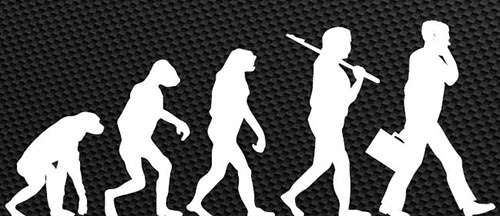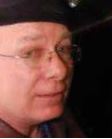
Evolutionary Benchmarking


Evolution is nature’s experiment. It isn’t a science, as no math is involved except for those trying to figure out why we evolved this way or that. Nature experiments with varieties. If it is beneficial then it remains; if it doesn’t, it is molded into something else. With climate changes, the dinosaurs (as with most species of the time) were no longer a viable structure for life and couldn’t sustain themselves (adapt) until a meteor eventually stuck a fork in their existence 65 million years ago. A new breed of animal, the mammals, thrived because they were more adaptable to the new climate and came to the forefront. Although they existed during the dinosaur era, they did not thrive until the conditions were right. Mother Nature doesn’t make mistakes, so dinosaurs now reinvented themselves into smaller and more maintainable creatures: birds. As the mammal population flourished, the environment changed again and became colder. Mammals changed to have heavier coats of fur and more robust bodies. When the ice age subsided, this adaptation was no longer desirable and the Neanderthal, the wooly mammoth and other species drifted away. Mother Nature doesn’t make mistakes, but she certainly appears to make a lot of adjustments. This is the sign of an experimenter. She understands what to keep, what to discard and what to reshape.
Thomas Edison was not a scientist but an experimenter. When a reporter asked him about the 10,000 failures he experienced until he invented the light bulb, Edison replied, “I have not failed. I’ve just found 10,000 ways that won’t work.” If Edison were a scientist, he might have been able to pare those 10,000 experiments down to a few hundred or less plausible trials. What would be lost then is the breadth of knowledge that comes with conducting those implausible experiments.
A scientist at 3M was working on developing a new super strong adhesive and created one that didn’t stick well. Who would want a glue that didn’t stick? Since that didn’t fit the hypothesis, and with the keen focus of a scientist, he discarded this idea and continued his research until another individual found a use for the adhesive by applying it to small pieces of paper that could be applied to several types of surfaces, could be reused and would not harm the surface it was attached to. The post-it note was a resounding success. Although experimentation has merit, it is not better than science — it’s just different, like a shot gun verses a rifle.
Adjusting to changing conditions
Organizations need to do the same thing: adjust to the changing conditions in which they work. Sometimes we can predict that change is coming because of emerging technologies, a change in customer needs, or a shift in managerial focus, etc. Sometimes these external changes are not predictable so organizations must be structurally limber to dodge and weave, like a boxer, and not to stand put because you’ll get punched. Polaroid stood solid on its mission and vision without considering the changes taking place in the camera market and is no longer in existence.
Research-In-Motion (RIM) the manufacturers of Blackberry, once the leaders in the industry, didn’t adapt fast enough or soon enough to market changes and is now struggling. They were blinded by their own success and should change their name to Research-Is-Motionless; at least they can keep the acronym. Kodak had developed digital photography but insisted on focusing on film photography and lost vital market share. Bending to increased demand, a slight manufacturing shift from concentrating on quality to production led Toyota, the originator of many quality concepts, to produce cars with faulty gas pedals. The divide between what top management understood to be real led BP, an organization that prides itself on safety, to the biggest oil spill in history.
More recently, we can cite crash of a pilotless runaway Metra train that crashed into a stopped commuter train, injuring dozens of people in Chicago. Metra management discovered that an employee left a train running in the yard without being attended as he accomplished repairs. Top management had found their victim as this was against company policy; they were ready to crucify the person and call the matter resolved. However, the union said, “wait a minute,” that this was common practice and, “is the way it has always been done.” How many times have you heard that one? What is the reality? It depends on your perspective and is probably somewhere in between, but firing the employee does not resolve the problem and will undoubtedly do more harm than good.
Root cause analysis
You got rid of the problem employee, so how can that be a bad thing? The employee might have been a problem child where this action is necessary but this is not the end of the story. Root cause analysis is taken too literally. It is going to be a rare occurrence when you have only one root cause; it is more common to have root causes.
How did I get from evolution to root cause analysis? What do these disconnects between the ideal state and the real state have to do with evolution? They work together. You perform root cause analysis when you have a problem. But what are problems other than opportunities to improve, to evolve? Evolution shifts the norm and realigns the ideal state with the real state. No matter how miniscule, over time all those miniscule movements are quite large. The dinosaurs might have died off instantly in Earth time but they were around for 65 million years and it took hundreds of thousands of years to evolve to where they are now. Primates can be traced back to 65 million years. The genus Homo Erectus has been around for about 2.5 million years but it has changed. The Neanderthals might have been around for less than a blink of an eye in Earth terms but lasted 300,000 years, whereas Homo Sapien Sapien (modern man) has been on this Earth for less than 100,000 years. Looking at evolution with a wide scope, it is progression and never regression. We evolve to a higher state. It is a constant state of adjustment of the ideal to the environment and the reality to the ideal.
Lessons from evolution
Evolution is slow to adapt and slow to change but it shows us two things. First, change occurs for two reasons: we change internally to take advantage of opportunities or we change due to influences from outside pressures. This is an age-old discussion of nature versus nurture. Are we predisposed to our actions or are our actions molded due to our environment? Are criminals born or are they products of their upbringings? Research shows that both are true. This is why you have some people rise out of terrible surroundings and become successful, while others who do horrendous crimes came out of good households and were raised in a good environment.
Second, in order for change to occur, the organization must be flexible to adopt new ideas and adapt them to your environment. It is an experiment with a dash of science, i.e., root causes analysis. You don’t know what is going to work until you try it but you also don’t just try things willy-nilly without a good probability of success. A good probability means that there is also a probability of failure. Don’t delude your thinking that “a good probability of success” means a sure thing. It also is not a matter of numbers, where the more you try eventually something will work. This only victimizes the workforce but they wise up quickly into the, “here we go again, the program of the month club” mentality and people start taking bets how long this one will last. You make bets on probabilities not inevitabilities, so notice that this is not a bet on success or failure. To them, failure is a sure thing. The probability is the timing. (When will it collapse?) The employees won’t help in success, so why put forth any effort on something destined for failure? They will also not waste their energy working to ensure failure for the same reason. As George S. Patton said, “Take calculated risks. That is quite different from being rash.”
Benchmarking
We must affect changes just to maintain the status quo. This occurs with benchmarking. We emulate those who are successful because we believe that we will achieve the same success. Notice that nature doesn’t just benchmark; evolution isn’t concerned with maintaining status quo — it is concerned with progression, adaptation and improvement.
If the benchmarked organization is the leader and successful in its efforts and you emulate those activities, don’t expect to also achieve the same success rate. There is some deterioration in knowledge transference. Let’s be conservative and say you have a 10-percent transference loss, so you will be 90 percent as successful as the organization benchmarked. What if the organization you just benchmarked was not the leader and they benchmarked someone else? If they were not 100-percent successful, your knowledge transference loss of 10 percent puts you further down the evolutionary success track. You are now not benchmarking a leader to keep up — you are benchmarking a follower and falling further behind. The only way to lead is to be in front, not next to or behind. You want to be the organization that is being benchmarked. Benchmarking only provides the benefit of not wasting energy in duplicating work. You only get ahead and evolve if you benchmark and innovate. Then others will benchmark you, add enhancements and jump ahead. It’s a leap frog game, so being the benchmark leader is only temporary.
You can never replicate another organization’s success perfectly. Even clones have variances. If your interpretation of success of your organization is to mimic another organization, then you will be working at a deficit and have to share a finite market. Over time, nature has adapted what worked and improved upon what didn’t. It benchmarked and enhanced, so we have variety. Benchmarking is great for achieving success, but like genius, it is built on the shoulders of others. Read that closely — you build on the shoulders of others, not ride their backs.

 Patrick Kinane is an FAA-certificated A&P with IA and commercial pilot with instrument rating. He has 50 years of experience in aviation maintenance. He is an ASQ senior member with quality auditor and quality systems/organizational excellence manager certifications. He is an RABQSA-certified AS9100 and AS9110 aerospace industry experienced auditor and ISO9001 business improvement/quality management systems auditor. He earned a bachelor of science degree in aviation maintenance management, a master’s of science degree in education, and a Ph.D. in organizational psychology. Kinane is presently a senior quality management systems auditor for AAR CORP and a professor of organizational behavior at DeVry University.
Patrick Kinane is an FAA-certificated A&P with IA and commercial pilot with instrument rating. He has 50 years of experience in aviation maintenance. He is an ASQ senior member with quality auditor and quality systems/organizational excellence manager certifications. He is an RABQSA-certified AS9100 and AS9110 aerospace industry experienced auditor and ISO9001 business improvement/quality management systems auditor. He earned a bachelor of science degree in aviation maintenance management, a master’s of science degree in education, and a Ph.D. in organizational psychology. Kinane is presently a senior quality management systems auditor for AAR CORP and a professor of organizational behavior at DeVry University.
